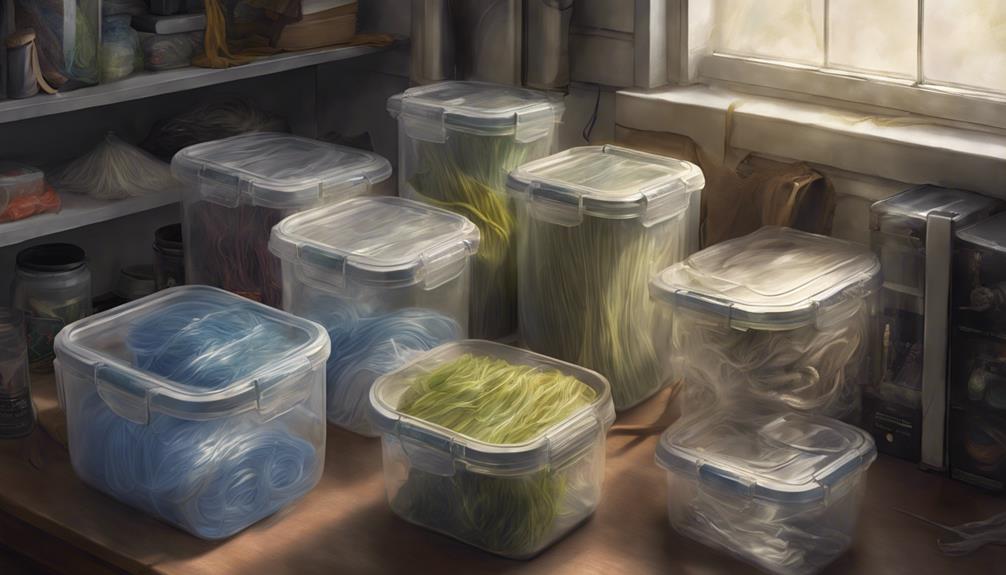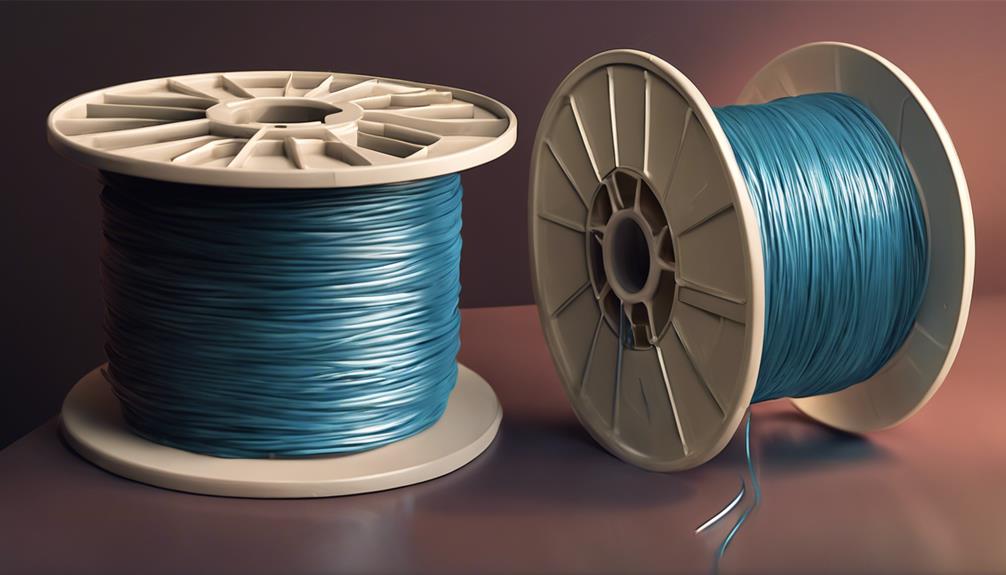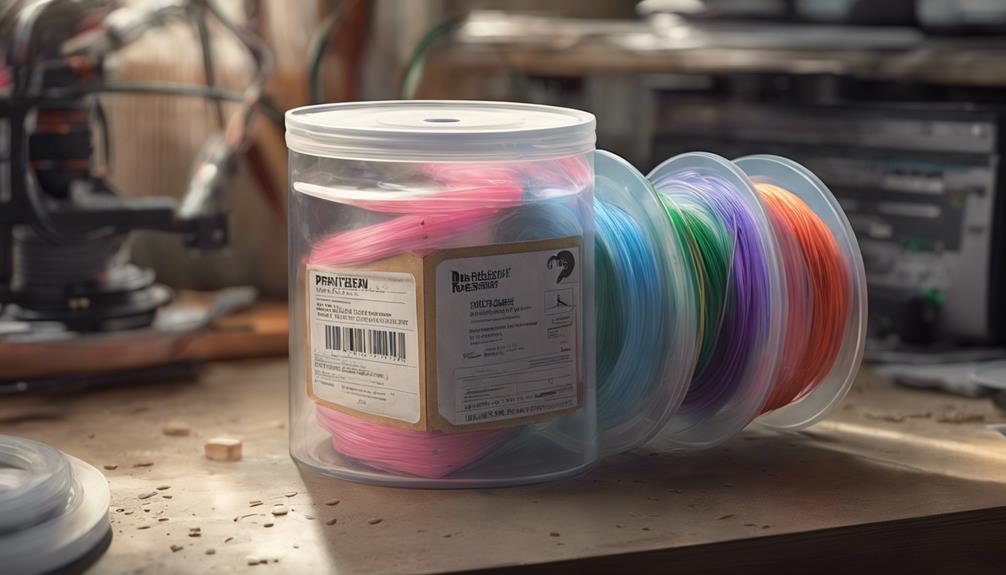You might not be aware that the way you store your 3D printing filament can have a substantial impact on its lifespan and quality. Have you ever considered how temperature and humidity control play an essential role in preserving your PLA, ABS, PETG, or Nylon filaments? Understanding the secrets behind proper storage techniques could be the key to enhancing consistent print quality and prolonging the longevity of your filament.
Importance of Proper Filament Storage

Proper filament storage plays an essential role in maintaining the quality and longevity of 3D printing materials. When storing filaments like PLA, ABS, or PETG, it's important to shield them from heat, humidity, and UV exposure.
For instance, PLA and ABS can last 2-3 years if kept in a dry environment away from sunlight. Nylon, being highly hygroscopic, should be used within a year and stored in a moisture-free space. PETG, with a shelf life of 2 years, requires an airtight container in a low-moisture setting.
Understanding Filament Shelf Life
Understanding the lifespan of filaments is important for maintaining print quality and avoiding unnecessary waste. Different filaments have varying shelf lives. For instance, PLA and ABS can last up to 2 years if stored correctly, while Nylon has a shorter shelf life of around 12 months due to its hygroscopic nature. Factors like temperature and humidity play a vital role in filament longevity.
Proper storage conditions are key to preserving filament quality. For best results, make sure PLA and ABS are shielded from heat and UV exposure, Nylon is kept dry, and PETG is stored in an airtight container away from moisture. By understanding filament shelf life, you can maximize the lifespan of your filaments and produce high-quality prints.
Impact of Moisture on Filament Quality

High humidity can greatly degrade filament quality, impacting your 3D prints. Moisture absorption in filament leads to low-quality prints and filament breakage. Signs of moisture include stretched, stringy filament and popping noises during extrusion.
When filament absorbs moisture, it markedly affects print quality and can cause breakage. Proper storage conditions are essential to prevent moisture accumulation and maintain filament quality. To fix moisture-absorbed filament, desiccate it in an oven at 40°C for 3 hours. Consider using food dehydrators or filament dryers to secure the temperature stays below 60°C.
Proper storage involves using airtight containers, silica gel packets, and storing in a dry environment. Prevent moisture damage by implementing these effective storage techniques.
Effective Moisture Removal Techniques
To effectively remove moisture from filament and maintain its quality, consider utilizing desiccating methods such as using an oven or a food dehydrator. When dealing with moisture absorption in filament, the following techniques can be beneficial:
- Place filament in an oven at 40°C for 3 hours to eliminate moisture.
- Use a food dehydrator to gradually dry out the filament, ensuring the temperature remains below 60°C.
- Store filament in airtight containers to prevent moisture from seeping in.
- Employ silica gel packets within storage containers to absorb any excess humidity.
- Opt for a dry environment to store filament, reducing the chances of moisture absorption and preserving filament quality.
Best Practices for Filament Safety

Implementing proper safety measures when handling filament is key to maintaining quality prints and preventing accidents. Here are some best practices to guarantee filament safety:
| Best Practices | Description | Importance |
|---|---|---|
| Wear protective gear | Use gloves and safety glasses to prevent skin irritation and eye injuries. | Ensures personal safety |
| Keep work area clean | Remove clutter to prevent tripping hazards and maintain a clear workspace for filament handling. | Prevents accidents |
| Store filaments properly | Use airtight containers and desiccants to maintain filament quality and prevent moisture absorption. | Extends filament lifespan |
| Educate on filament safety | Inform others about safe filament handling practices to prevent misuse and accidents. | Promotes safety awareness |
Frequently Asked Questions
Can Filament Be Salvaged After Exposure to High Humidity?
Yes, filament can be salvaged after exposure to high humidity. To restore it, desiccate in an oven at 40°C for 3 hours. Use food dehydrators or filament dryers below 60°C. Store properly in airtight containers with silica gel packets.
Are There Any DIY Methods to Dry Filament Effectively?
To dry filament effectively at home, use an oven at 40°C for 3 hours or a food dehydrator below 60°C. Store in airtight containers with silica gel or rice. Prevent moisture absorption to maintain quality and avoid filament damage.
How Can I Tell if My Filament Has Absorbed Moisture?
To check if your filament absorbed moisture, watch for stretched, stringy texture and popping extrusion noises. If these signs appear, dry the filament at 40°C for 3 hours. Guarantee proper storage in airtight containers to prevent future issues.
What Are the Risks of Using Expired Filament for Printing?
Using expired filament for printing poses risks like poor adhesion, brittle prints, and clogs. Avoid compromising your prints by discarding expired filament. Prioritize quality by opting for fresh, properly stored filament for successful 3D printing projects.
Is It Necessary to Store Different Filaments Separately?
You should store different filaments separately to maintain their quality. For instance, storing moisture-sensitive nylon away from humid environments helps prevent degradation. Keeping filaments in ideal conditions prolongs their lifespan and guarantees successful printing results.
Conclusion
So, now that you've uncovered the secrets of filament storage, you're all set to keep your 3D printing materials in excellent condition. Remember, a little TLC goes a long way in preserving filament quality and ensuring flawless prints.
With these storage tips in your toolkit, you'll be well-equipped to create stunning creations without any worries about filament longevity.
Happy printing!